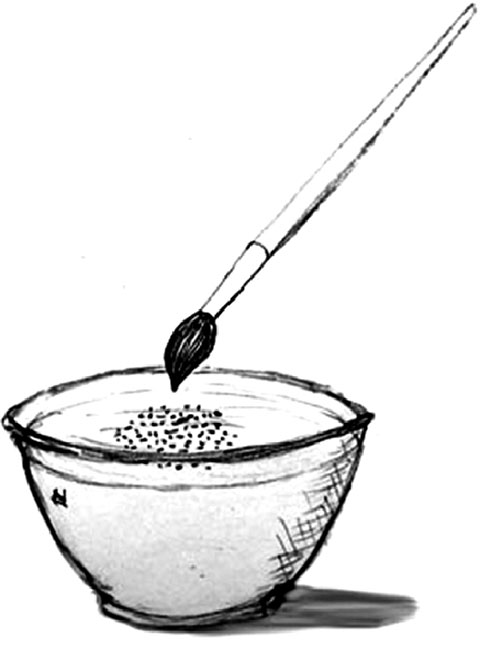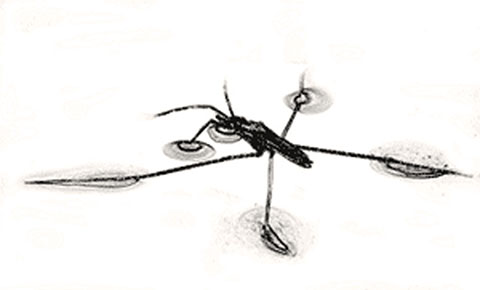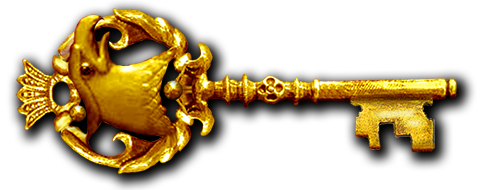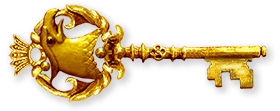
Experiment 3
Who Jumped in Bophut pond?
Ms Crowler is bubbling with charm when she answers her door and apologizes for her soggy appearance. Was she wet because she was evading being seen by jumping in Bophut pond or did she just jump out of the shower to greet her unexpected guests? A few minutes later while sitting down to have a snack Ms. Crowler’s hair touched the water in the bowl of floating suckelberry seeds causing the seeds to scatter towards the edge of the bowl. Is this a clue to whether or not Ms. Crowler was telling the truth about jumping out of the shower before she had time to rinse the soap from her hair?

I. Hypothesis
Soap will break the surface tension of water causing floating objects to either sink or scatter to places where the surface tension remains.
II. Materials needed
- a large bowl (soup bowl or larger)
- water
- pepper (or substitute pepper with dried sesame seeds)
- soap (dish soap or shampoo)
- two paintbrushes
III. Procedure/Observation
- Place a bowl of water on the table. Let it rest until the water is calm. Sprinkle some pepper on the surface of the water.
- Wet one of the paint brushes and then gently dip the tip of that paintbrush into the bowl of pepper covered water. What happens?
- Dip the the other paintbrush into some dish soap or shampoo.
- Gently dip the tip your soap-covered paintbrush into the bowl of pepper covered water. What happens?
IV] Detective Conclusions:
Now that you have observed how a wet paintbrush compares to a wet soapy paintbrush when dipped in a bowl of floating pepper, what can you conclude about Ms. Crowler’s hair? Was she the snodlop who jumped into Bophut Pond to escape being caught?
V] Further Exploration: What is the surface tension of water?
You may know most things are slippery when wet. But water molecules, when it comes to other water molecules, are sticky. This is because water molecules have a strong attraction to each other.*
In the center of a glass of water, the molecules are sticking to other water molecules in all directions because they are all attracted to each other. Think of all the water molecules pulling towards each other, like if you had a glass of magnets all attracting each other.
At the surface, there are no water molecules above for them to stick to, so there is nothing pulling the surface molecules up. These surface molecules therefore stick more to the molecules next to them than other water molecules below them. This extra stickiness forms a “skin” at the surface of the water that is called surface tension. Surface tension is what causes water to form circular drops on the surface of a clean car.
*Water molecules stick to each other because of their molecular make-up. Each water molecule is made of two hydrogen atoms (H) and one oxygen atom (O). The molecule may remind you of Mickey Mouse™ (see image below). The hydrogen side of the water molecule tends to be slightly positive and the oxygen side of the molecule tends to be slightly negative. Positive and negative charges attract each other, so water molecules positive sides are attracted to other water molecules negative sides. This attraction known as hydrogen bonding is what makes water sticky (at least at its molecular level).

VI] Relating to the Environment
- Small insects such as the water strider can walk on water because surface tension is strong enough to support their weight.

- Disinfectants are usually solutions of low surface tension. This allows them to spread out on the cell walls of bacteria and disrupt them.
- Tents are somewhat waterproof because the surface tension of water will bridge the pores in the finely woven fabric. But if you touch the tent fabric with your finger, you break the surface tension, which allows the rain to drip through.

